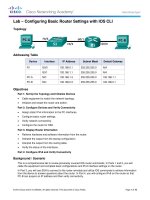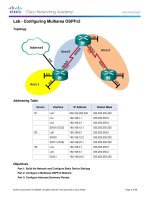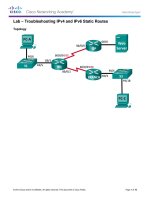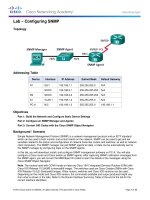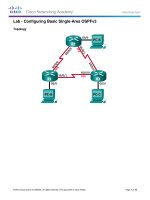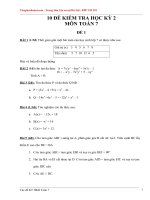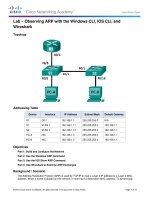6 2 3 9 lab configuring multiarea OSPFv3 kho tài liệu bách khoa
Bạn đang xem bản rút gọn của tài liệu. Xem và tải ngay bản đầy đủ của tài liệu tại đây (306.49 KB, 11 trang )
Lab - Configuring Multiarea OSPFv3
Topology
© 2013 Cisco and/or its affiliates. All rights reserved. This document is Cisco Public.
Page 1 of 11
Lab - Configuring Multiarea OSPFv3
Addressing Table
Device
R1
R2
R3
Interface
IPv6 Address
Default Gateway
S0/0/0 (DCE)
2001:DB8:ACAD:12::1/64
FE80::1 link-local
N/A
Lo0
2001:DB8:ACAD::1/64
N/A
Lo1
2001:DB8:ACAD:1::1/64
N/A
Lo2
2001:DB8:ACAD:2::1/64
N/A
Lo3
2001:DB8:ACAD:3::1/64
N/A
S0/0/0
2001:DB8:ACAD:12::2/64
FE80::2 link-local
N/A
S0/0/1 (DCE)
2001:DB8:ACAD:23::2/64
FE80::2 link-local
N/A
Lo8
2001:DB8:ACAD:8::1/64
N/A
S0/0/1
2001:DB8:ACAD:23::3/64
FE80::3 link-local
N/A
Lo4
2001:DB8:ACAD:4::1/64
N/A
Lo5
2001:DB8:ACAD:5::1/64
N/A
Lo6
2001:DB8:ACAD:6::1/64
N/A
Lo7
2001:DB8:ACAD:7::1/64
N/A
Objectives
Part 1: Build the Network and Configure Basic Device Settings
Part 2: Configure Multiarea OSPFv3 Routing
Part 3: Configure Interarea Route Summarization
Background / Scenario
Using multiarea OSPFv3 in large IPv6 network deployments can reduce router processing by creating smaller
routing tables and requiring less memory overhead. In multiarea OSPFv3, all areas are connected to the
backbone area (area 0) through area border routers (ABRs).
In this lab, you will implement OSPFv3 routing for multiple areas and configure interarea route
summarizations on the Area Border Routers (ABRs). You will also use a number of show commands to
display and verify OSPFv3 routing information. This lab uses loopback addresses to simulate networks in
multiple OSPFv3 areas.
Note: The routers used with CCNA hands-on labs are Cisco 1941 Integrated Services Routers (ISRs) with
Cisco IOS Release 15.2(4)M3 (universalk9 image). Other routers and Cisco IOS versions can be used.
Depending on the model and Cisco IOS version, the commands available and output produced might vary
from what is shown in the labs. Refer to the Router Interface Summary Table at this end of this lab for the
correct interface identifiers.
Note: Make sure that the routers have been erased and have no startup configurations. If you are unsure,
contact your instructor.
© 2013 Cisco and/or its affiliates. All rights reserved. This document is Cisco Public.
Page 2 of 11
Lab - Configuring Multiarea OSPFv3
Required Resources
3 Routers (Cisco 1941 with Cisco IOS Release 15.2(4)M3 universal image or comparable)
3 PCs (Windows 7, Vista, or XP with terminal emulation program, such as Tera Term)
Console cables to configure the Cisco IOS devices via the console ports
Serial cables as shown in the topology
Part 1: Build the Network and Configure Basic Device Settings
In Part 1, you will set up the network topology and configure basic settings on the routers.
Step 1: Cable the network as shown in the topology.
Step 2: Initialize and reload the routers as necessary.
Step 3: Configure basic settings for each router.
a. Disable DNS lookup.
b. Configure device name as shown in the topology.
c.
Assign class as the privileged EXEC password.
d. Assign cisco as the vty password.
e. Configure a MOTD banner to warn users that unauthorized access is prohibited.
f.
Configure logging synchronous for the console line.
g. Encrypt plain text passwords.
h. Configure the IPv6 unicast and link-local addresses listed in the Addressing Table for all interfaces.
i.
Enable IPv6 unicast routing on each router.
j.
Copy the running configuration to the startup configuration.
Step 4: Test connectivity.
The routers should be able to ping one another. The routers are unable to ping distant loopbacks until
OSPFv3 routing is configured. Verify and troubleshoot if necessary.
Part 2: Configure Multiarea OSPFv3 Routing
In Part 2, you will configure OSPFv3 routing on all routers to separate the network domain into three distinct
areas, and then verify that routing tables are updated correctly.
Step 1: Assign router IDs.
a. On R1, issue the ipv6 router ospf command to start an OSPFv3 process on the router.
R1(config)# ipv6 router ospf 1
Note: The OSPF process ID is kept locally and has no meaning to other routers on the network.
b. Assign the OSPFv3 router ID 1.1.1.1 to R1.
R1(config-rtr)# router-id 1.1.1.1
c.
Assign a router ID of 2.2.2.2 to R2 and a router ID of 3.3.3.3 to R3.
© 2013 Cisco and/or its affiliates. All rights reserved. This document is Cisco Public.
Page 3 of 11
Lab - Configuring Multiarea OSPFv3
d. Issue the show ipv6 ospf command to verify the router IDs on all routers.
R2# show ipv6 ospf
Routing Process "ospfv3 1" with ID 2.2.2.2
Event-log enabled, Maximum number of events: 1000, Mode: cyclic
Router is not originating router-LSAs with maximum metric
<output omitted>
Step 2: Configure multiarea OSPFv3.
a. Issue the ipv6 ospf 1 area area-id command for each interface on R1 that is to participate in OSPFv3
routing. The loopback interfaces are assigned to area 1 and the serial interface is assigned to area 0. You
will change the network type on the loopback interfaces to ensure that the correct subnet is advertised.
R1(config)# interface lo0
R1(config-if)# ipv6 ospf 1 area 1
R1(config-if)# ipv6 ospf network point-to-point
R1(config-if)# interface lo1
R1(config-if)# ipv6 ospf 1 area 1
R1(config-if)# ipv6 ospf network point-to-point
R1(config-if)# interface lo2
R1(config-if)# ipv6 ospf 1 area 1
R1(config-if)# ipv6 ospf network point-to-point
R1(config-if)# interface lo3
R1(config-if)# ipv6 ospf 1 area 1
R1(config-if)# ipv6 ospf network point-to-point
R1(config-if)# interface s0/0/0
R1(config-if)# ipv6 ospf 1 area 0
b. Use the show ipv6 protocols command to verify multiarea OSPFv3 status.
R1# show ipv6 protocols
IPv6 Routing Protocol is "connected"
IPv6 Routing Protocol is "ND"
IPv6 Routing Protocol is "ospf 1"
Router ID 1.1.1.1
Area border router
Number of areas: 2 normal, 0 stub, 0 nssa
Interfaces (Area 0):
Serial0/0/0
Interfaces (Area 1):
Loopback0
Loopback1
Loopback2
Loopback3
Redistribution:
None
© 2013 Cisco and/or its affiliates. All rights reserved. This document is Cisco Public.
Page 4 of 11
Lab - Configuring Multiarea OSPFv3
c.
Assign all interfaces on R2 to participate in OSPFv3 area 0. For the loopback interface, change the
network type to point-to point. Write the commands used in the space below.
d. Use the show ipv6 ospf interface brief command to view OSPFv3 enabled interfaces.
R2# show ipv6 ospf interface brief
Interface
Lo8
Se0/0/1
Se0/0/0
PID
1
1
1
Area
0
0
0
Intf ID
13
7
6
Cost
1
64
64
State
P2P
P2P
P2P
Nbrs F/C
0/0
1/1
1/1
e. Assign the loopback interfaces on R3 to participate in OSPFv3 area 2 and change the network type to
point-to-point. Assign the serial interface to participate in OSPFv3 area 0. Write the commands used in
the space below.
f.
Use the show ipv6 ospf command to verify configurations.
R3# show ipv6 ospf
Routing Process "ospfv3 1" with ID 3.3.3.3
Event-log enabled, Maximum number of events: 1000, Mode: cyclic
It is an area border router
Router is not originating router-LSAs with maximum metric
Initial SPF schedule delay 5000 msecs
Minimum hold time between two consecutive SPFs 10000 msecs
Maximum wait time between two consecutive SPFs 10000 msecs
Minimum LSA interval 5 secs
Minimum LSA arrival 1000 msecs
LSA group pacing timer 240 secs
Interface flood pacing timer 33 msecs
Retransmission pacing timer 66 msecs
Number of external LSA 0. Checksum Sum 0x000000
Number of areas in this router is 2. 2 normal 0 stub 0 nssa
Graceful restart helper support enabled
© 2013 Cisco and/or its affiliates. All rights reserved. This document is Cisco Public.
Page 5 of 11
Lab - Configuring Multiarea OSPFv3
Reference bandwidth unit is 100 mbps
RFC1583 compatibility enabled
Area BACKBONE(0)
Number of interfaces in this area is 1
SPF algorithm executed 2 times
Number of LSA 16. Checksum Sum 0x0929F8
Number of DCbitless LSA 0
Number of indication LSA 0
Number of DoNotAge LSA 0
Flood list length 0
Area 2
Number of interfaces in this area is 4
SPF algorithm executed 2 times
Number of LSA 13. Checksum Sum 0x048E3C
Number of DCbitless LSA 0
Number of indication LSA 0
Number of DoNotAge LSA 0
Flood list length 0
Step 3: Verify OSPFv3 neighbors and routing information.
a. Issue the show ipv6 ospf neighbor command on all routers to verify that each router is listing the correct
routers as neighbors.
R1# show ipv6 ospf neighbor
OSPFv3 Router with ID (1.1.1.1) (Process ID 1)
Neighbor ID
2.2.2.2
Pri
0
State
FULL/
-
Dead Time
00:00:39
Interface ID
6
Interface
Serial0/0/0
b. Issue the show ipv6 route ospf command on all routers to verify that each router has learned routes to
all networks in the Addressing Table.
R1# show ipv6 route ospf
IPv6 Routing Table - default - 16 entries
Codes: C - Connected, L - Local, S - Static, U - Per-user Static route
B - BGP, R - RIP, H - NHRP, I1 - ISIS L1
I2 - ISIS L2, IA - ISIS interarea, IS - ISIS summary, D - EIGRP
EX - EIGRP external, ND - ND Default, NDp - ND Prefix, DCE - Destination
NDr - Redirect, O - OSPF Intra, OI - OSPF Inter, OE1 - OSPF ext 1
OE2 - OSPF ext 2, ON1 - OSPF NSSA ext 1, ON2 - OSPF NSSA ext 2
OI 2001:DB8:ACAD:4::/64 [110/129]
via FE80::2, Serial0/0/0
OI 2001:DB8:ACAD:5::/64 [110/129]
via FE80::2, Serial0/0/0
OI 2001:DB8:ACAD:6::/64 [110/129]
via FE80::2, Serial0/0/0
OI 2001:DB8:ACAD:7::/64 [110/129]
via FE80::2, Serial0/0/0
O
2001:DB8:ACAD:8::/64 [110/65]
via FE80::2, Serial0/0/0
© 2013 Cisco and/or its affiliates. All rights reserved. This document is Cisco Public.
Page 6 of 11
Lab - Configuring Multiarea OSPFv3
O
2001:DB8:ACAD:23::/64 [110/128]
via FE80::2, Serial0/0/0
What is the significance of an OI route?
c.
Issue the show ipv6 ospf database command on all routers.
R1# show ipv6 ospf database
OSPFv3 Router with ID (1.1.1.1) (Process ID 1)
Router Link States (Area 0)
ADV Router
1.1.1.1
2.2.2.2
3.3.3.3
Age
908
898
899
Seq#
0x80000001
0x80000003
0x80000001
Fragment ID
0
0
0
Link count
1
2
1
Bits
B
None
B
Inter Area Prefix Link States (Area 0)
ADV Router
1.1.1.1
3.3.3.3
Age
907
898
Seq#
0x80000001
0x80000001
Prefix
2001:DB8:ACAD::/62
2001:DB8:ACAD:4::/62
Link (Type-8) Link States (Area 0)
ADV Router
1.1.1.1
2.2.2.2
Age
908
909
Seq#
0x80000001
0x80000002
Link ID
6
6
Interface
Se0/0/0
Se0/0/0
Intra Area Prefix Link States (Area 0)
ADV Router
1.1.1.1
2.2.2.2
3.3.3.3
Age
908
898
899
Seq#
0x80000001
0x80000003
0x80000001
Link ID
0
0
0
Ref-lstype
0x2001
0x2001
0x2001
Ref-LSID
0
0
0
Router Link States (Area 1)
ADV Router
1.1.1.1
Age
908
Seq#
0x80000001
Fragment ID
0
Link count
0
Bits
B
Inter Area Prefix Link States (Area 1)
ADV Router
1.1.1.1
1.1.1.1
1.1.1.1
1.1.1.1
Age
907
907
888
888
Seq#
0x80000001
0x80000001
0x80000001
0x80000001
Prefix
2001:DB8:ACAD:12::/64
2001:DB8:ACAD:8::/64
2001:DB8:ACAD:23::/64
2001:DB8:ACAD:4::/62
© 2013 Cisco and/or its affiliates. All rights reserved. This document is Cisco Public.
Page 7 of 11
Lab - Configuring Multiarea OSPFv3
Link (Type-8) Link States (Area 1)
ADV Router
1.1.1.1
1.1.1.1
1.1.1.1
1.1.1.1
Age
908
908
908
908
Seq#
0x80000001
0x80000001
0x80000001
0x80000001
Link ID
13
14
15
16
Interface
Lo0
Lo1
Lo2
Lo3
Intra Area Prefix Link States (Area 1)
ADV Router
1.1.1.1
Age
908
Seq#
0x80000001
Link ID
0
Ref-lstype
0x2001
Ref-LSID
0
How many link state databases are found on R1?
How many link state databases are found on R2?
How many link state databases are found on R3?
Part 3: Configure Interarea Route Summarization
In Part 3, you will manually configure interarea route summarization on the ABRs.
Step 1: Summarize networks on R1.
a. List the network addresses for the loopback interfaces and identify the hextet section where the
addresses differ.
2001:DB8:ACAD:0000::1/64
2001:DB8:ACAD:0001::1/64
2001:DB8:ACAD:0002::1/64
2001:DB8:ACAD:0003::1/64
b. Convert the differing section from hex to binary.
2001:DB8:ACAD: 0000 0000 0000 0000::1/64
2001:DB8:ACAD: 0000 0000 0000 0001::1/64
2001:DB8:ACAD: 0000 0000 0000 0010::1/64
2001:DB8:ACAD: 0000 0000 0000 0011::1/64
c.
Count the number of leftmost matching bits to determine the prefix for the summary route.
2001:DB8:ACAD: 0000 0000 0000 0000::1/64
2001:DB8:ACAD: 0000 0000 0000 0001::1/64
2001:DB8:ACAD: 0000 0000 0000 0010::1/64
2001:DB8:ACAD: 0000 0000 0000 0011::1/64
How many bits match?
d. Copy the matching bits and then add zero bits to determine the summarized network address.
2001:DB8:ACAD: 0000 0000 0000 0000::0
© 2013 Cisco and/or its affiliates. All rights reserved. This document is Cisco Public.
Page 8 of 11
Lab - Configuring Multiarea OSPFv3
e. Convert the binary section back to hex.
2001:DB8:ACAD::
f.
Append the prefix of the summary route (result of Step 1c).
2001:DB8:ACAD::/62
Step 2: Configure interarea route summarization on R1.
a. To manually configure interarea route summarization on R1, use the area area-id range address mask
command.
R1(config)# ipv6 router ospf 1
R1(config-rtr)# area 1 range 2001:DB8:ACAD::/62
b. View the OSPFv3 routes on R3.
R3# show ipv6 route ospf
IPv6 Routing Table - default - 14 entries
Codes: C - Connected, L - Local, S - Static, U - Per-user Static route
B - BGP, R - RIP, H - NHRP, I1 - ISIS L1
I2 - ISIS L2, IA - ISIS interarea, IS - ISIS summary, D - EIGRP
EX - EIGRP external, ND - ND Default, NDp - ND Prefix, DCE - Destination
NDr - Redirect, O - OSPF Intra, OI - OSPF Inter, OE1 - OSPF ext 1
OE2 - OSPF ext 2, ON1 - OSPF NSSA ext 1, ON2 - OSPF NSSA ext 2
OI 2001:DB8:ACAD::/62 [110/129]
via FE80::2, Serial0/0/1
O
2001:DB8:ACAD:8::/64 [110/65]
via FE80::2, Serial0/0/1
O
2001:DB8:ACAD:12::/64 [110/128]
via FE80::2, Serial0/0/1
Compare this output to the output from Part 2, Step 3b. How are the networks in area 1 now expressed in
the routing table on R3?
c.
View the OSPFv3 routes on R1.
R1# show ipv6 route ospf
IPv6 Routing Table - default - 18 entries
Codes: C - Connected, L - Local, S - Static, U - Per-user Static route
B - BGP, R - RIP, H - NHRP, I1 - ISIS L1
I2 - ISIS L2, IA - ISIS interarea, IS - ISIS summary, D - EIGRP
EX - EIGRP external, ND - ND Default, NDp - ND Prefix, DCE - Destination
NDr - Redirect, O - OSPF Intra, OI - OSPF Inter, OE1 - OSPF ext 1
OE2 - OSPF ext 2, ON1 - OSPF NSSA ext 1, ON2 - OSPF NSSA ext 2
O
2001:DB8:ACAD::/62 [110/1]
via Null0, directly connected
OI 2001:DB8:ACAD:4::/64 [110/129]
via FE80::2, Serial0/0/0
OI 2001:DB8:ACAD:5::/64 [110/129]
via FE80::2, Serial0/0/0
OI 2001:DB8:ACAD:6::/64 [110/129]
via FE80::2, Serial0/0/0
© 2013 Cisco and/or its affiliates. All rights reserved. This document is Cisco Public.
Page 9 of 11
Lab - Configuring Multiarea OSPFv3
OI
O
O
2001:DB8:ACAD:7::/64 [110/129]
via FE80::2, Serial0/0/0
2001:DB8:ACAD:8::/64 [110/65]
via FE80::2, Serial0/0/0
2001:DB8:ACAD:23::/64 [110/128]
via FE80::2, Serial0/0/0
Compare this output to the output from Part 2, Step 3b. How are the summarized networks expressed in
the routing table on R1?
Step 3: Summarize networks and configure interarea route summarization on R3.
a. Summarize the loopback interfaces on R3.
1) List the network addresses and identify the hextet section where the addresses differ.
2) Convert the differing section from hex to binary.
3) Count the number of left-most matching bits to determine the prefix for the summary route.
4) Copy the matching bits and then add zero bits to determine the summarized network address.
5) Convert the binary section back to hex.
6) Append the prefix of the summary route.
Write the summary address in the space provided.
b. Manually configure interarea route summarization on R3. Write the commands in the space provided.
c.
Verify that area 2 routes are summarized on R1. What command was used?
d. Record the routing table entry on R1 for the summarized route advertised from R3.
Reflection
1. Why would multiarea OSPFv3 be used?
2. What is the benefit of configuring interarea route summarization?
© 2013 Cisco and/or its affiliates. All rights reserved. This document is Cisco Public.
Page 10 of 11
Lab - Configuring Multiarea OSPFv3
Router Interface Summary Table
Router Interface Summary
Router Model
Ethernet Interface #1
Ethernet Interface #2
Serial Interface #1
Serial Interface #2
1800
Fast Ethernet 0/0
(F0/0)
Fast Ethernet 0/1
(F0/1)
Serial 0/0/0 (S0/0/0)
Serial 0/0/1 (S0/0/1)
1900
Gigabit Ethernet 0/0
(G0/0)
Gigabit Ethernet 0/1
(G0/1)
Serial 0/0/0 (S0/0/0)
Serial 0/0/1 (S0/0/1)
2801
Fast Ethernet 0/0
(F0/0)
Fast Ethernet 0/1
(F0/1)
Serial 0/1/0 (S0/1/0)
Serial 0/1/1 (S0/1/1)
2811
Fast Ethernet 0/0
(F0/0)
Fast Ethernet 0/1
(F0/1)
Serial 0/0/0 (S0/0/0)
Serial 0/0/1 (S0/0/1)
2900
Gigabit Ethernet 0/0
(G0/0)
Gigabit Ethernet 0/1
(G0/1)
Serial 0/0/0 (S0/0/0)
Serial 0/0/1 (S0/0/1)
Note: To find out how the router is configured, look at the interfaces to identify the type of router and how many
interfaces the router has. There is no way to effectively list all the combinations of configurations for each router
class. This table includes identifiers for the possible combinations of Ethernet and Serial interfaces in the device.
The table does not include any other type of interface, even though a specific router may contain one. An
example of this might be an ISDN BRI interface. The string in parenthesis is the legal abbreviation that can be
used in Cisco IOS commands to represent the interface.
© 2013 Cisco and/or its affiliates. All rights reserved. This document is Cisco Public.
Page 11 of 11

